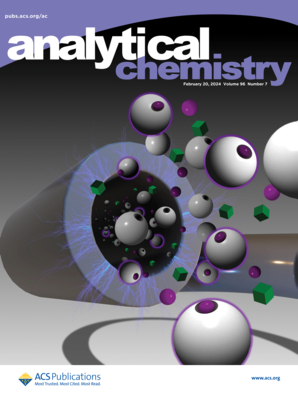从相对定量代谢组数据中阐明关键控制反应的 ΔΔG 方法:酵母糖酵解的比较分析
IF 6.7
1区 化学
Q1 CHEMISTRY, ANALYTICAL
引用次数: 0
摘要
本文章由计算机程序翻译,如有差异,请以英文原文为准。

ΔΔG Method for Elucidating Key Control Reactions from Relative Quantification Metabolome Data: Comparative Analysis of Yeast Glycolysis
This study introduces the ΔΔG method, a novel approach to analyzing metabolic regulation using relative quantification metabolome data. The method calculates shifts in the Gibbs free energy change (ΔG) in two different metabolic states. Subsequently, key reactions controlling the metabolic flux can be identified by comparing the ΔΔG values to the reaction rates. Two case studies demonstrated the applicability of this method. First, a metabolome data set was obtained from the wild-type and single-gene-deletion mutant strains of Saccharomyces cerevisiae. The ΔΔG values of the glycolytic reactions were calculated between those of the wild-type and each mutant strain. A positive correlation was observed between the ΔΔG values of phosphofructokinase (PFK) and the approximate glycolytic flux levels. These results suggested that PFK regulates glycolytic flux. Moreover, a comparison between S. cerevisiae (Crabtree-positive yeast) and Kluyveromyces marxianus (Crabtree-negative yeast) revealed that S. cerevisiae primarily regulates glycolysis through PFK, whereas K. marxianus employs a more distributed control. The ΔΔG method provides insights into metabolic regulation that are not apparent from metabolite profiles alone and is applicable to various biological systems, particularly for analyzing glycolysis. Furthermore, the simplicity of this method makes it a valuable tool for metabolic engineering and medical research.
求助全文
通过发布文献求助,成功后即可免费获取论文全文。
去求助
来源期刊

Analytical Chemistry
化学-分析化学
CiteScore
12.10
自引率
12.20%
发文量
1949
审稿时长
1.4 months
期刊介绍:
Analytical Chemistry, a peer-reviewed research journal, focuses on disseminating new and original knowledge across all branches of analytical chemistry. Fundamental articles may explore general principles of chemical measurement science and need not directly address existing or potential analytical methodology. They can be entirely theoretical or report experimental results. Contributions may cover various phases of analytical operations, including sampling, bioanalysis, electrochemistry, mass spectrometry, microscale and nanoscale systems, environmental analysis, separations, spectroscopy, chemical reactions and selectivity, instrumentation, imaging, surface analysis, and data processing. Papers discussing known analytical methods should present a significant, original application of the method, a notable improvement, or results on an important analyte.
 求助内容:
求助内容: 应助结果提醒方式:
应助结果提醒方式:


